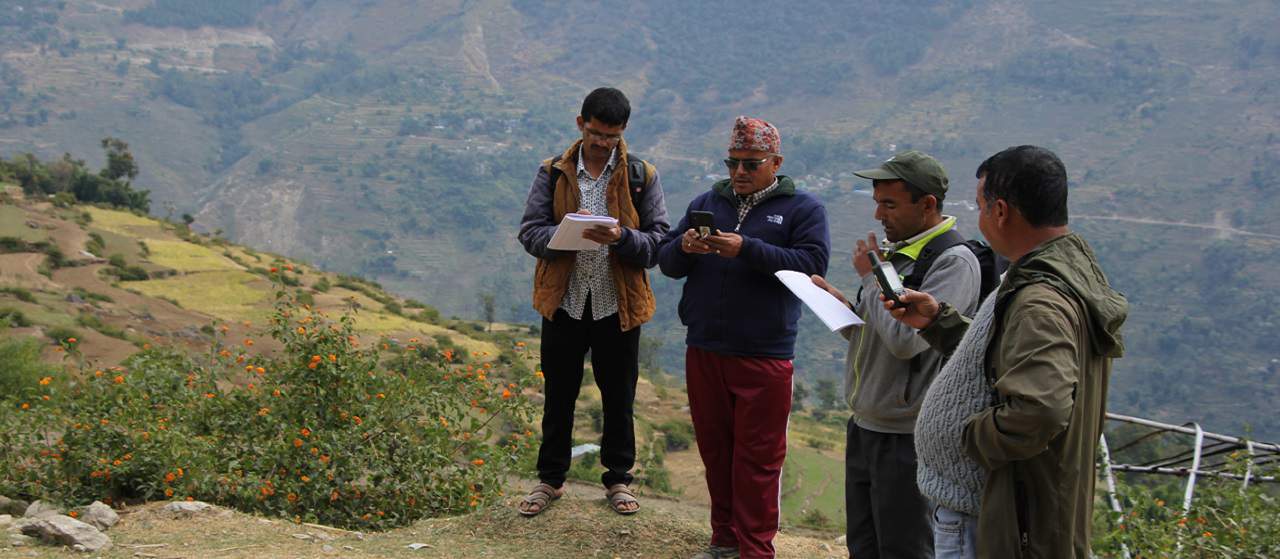
By Binod Prasad Parajuli
It is quite unusual for villagers from Nepal’s remote Bajura district to see 18 people from diverse backgrounds, from youth to senior citizens, busy collecting field data using GPS (global positioning system) and smartphones.
Recently, the locals of Budhiganga municipality got trained to digitally map their local resource and landmarks and upload them on the online platform OpenStreetMap. OpenStreetMap is a global initiative to create a complete map contributed by volunteers. It is freely available for everyone to use.
“We wish to create a task force who are readily available to map their own area whenever needed, we are confident that this will contribute to addressing the data gaps and will be crucial in the context of new federal structure,” says Uttam Pudasaini. He is the leader of the team who trained locals in Bajhang and Bajura districts.
Confident Locals
Participants showed great enthusiasm to map their areas as the results were instantly visible online. The experts’ team had remotely mapped whole areas of Bajhang and Bajura beforehand. Some information from the remote map about two municipalities was validated by the participants who collected the field-based data. A total of 41 locals from the two districts participated in the training and made contributions to the validation.
Mira Kumari Joshi, an information technology officer in Khaptad Chhededaha rural municipality, was one of the participants. She says, “We face many difficulties due to unavailability of digital information about our region. Now we are confident that we will be able to map our own area and use this to fulfil our own needs.”
Likewise, Khadak Singh Bista, a local school principal, says, “These kinds of technical skills need to be transferred to the local communities, which could greatly contribute to supporting local level developmental efforts”.
Support for Development Planning
With new federal structures in place, the local units in Nepal seem to be suffering from data deficiency and they have to start over from level zero. Most of the municipalities are still in the process of producing their municipality profile. Most importantly, if someone wishes to visit the municipality and ward offices, their location is not available online. Currently the only way is to ask local people about the location and rely on their knowledge.
During the fieldwork in Bajhang and Bajura, the team realized that even government authorities like ward offices were not digitally mapped. Therefore, it was very difficult to find the location for outsiders and even for people from within the community.
Hence, Deepak Shah, mayor of the Budhiganga municipality, states, “These kinds of information are important in making development plans and also tracking the road development in the area”.
Better Information for Disaster Resilience
Bajura is considered to be one of the most disaster-prone districts of the country. It is impacted by a diverse range of disasters. The situation is exacerbated by the impacts of global environmental changes. In this context, location-based information can play an important role during emergencies in this age of technology.
In cases of humanitarian emergencies, this information will be crucial. The information about key services including health posts, financial services, first aid, and the security forces are available online and for free. Also, humanitarian actors regurlaly rely on this kind of information for their activities. The community-mapped open spaces can also be used for evacuation, safe shelters and spots for landing helicopters during emergency situations.
On September 16, 2019, the Sanphe-Martadi road section at Balde of Budhiganga municipality in Bajura was blocked due to a massive landslide. There were many other active landslides in the districts, not mapped and located. With this mapping effort, some of the major landslides have been mapped and are available online. Most importantly, local people have been empowered to fill the data gap in the future.
In most of the developing countries, there is a lack of openly available geo-spatial data which makes it difficult for proper development planning. Lack of accurate data also contributes to increased environmental risks. Thus preventing local planners the opportunity to better identify their locally available resources and associated risks. If used properly, these new initiatives of open data could be crucial in better understanding environmental and development related risk and plan accordingly with minimum investment in other developing countries.
___
The views and opinions expressed in this article are those of the authors and do not necessarily reflect the views of the Global Solutions Initiative.
Editor’s Note: This article was originally published in OnlineKhabar.
___
 Binod, a Young Global Changer of 2017, is living and working in Nepal. As a research associate, he is part of a research team that collects data on the impact of climate change in rural areas. Their aim is to establish early warning systems in rural mountain parts of Nepal and decrease the likelihood of disasters after extreme climate changes.
Binod, a Young Global Changer of 2017, is living and working in Nepal. As a research associate, he is part of a research team that collects data on the impact of climate change in rural areas. Their aim is to establish early warning systems in rural mountain parts of Nepal and decrease the likelihood of disasters after extreme climate changes.
